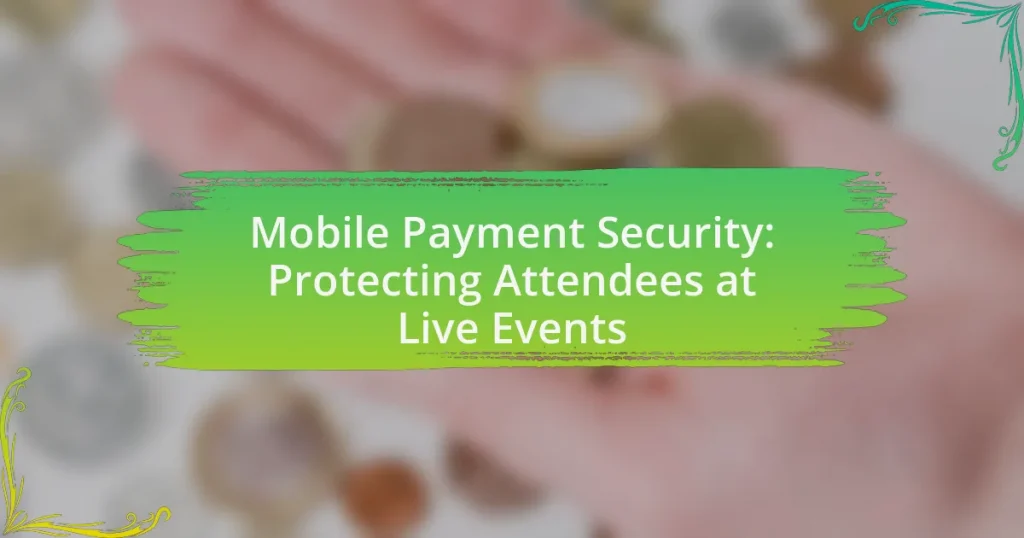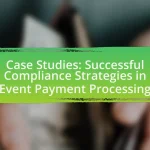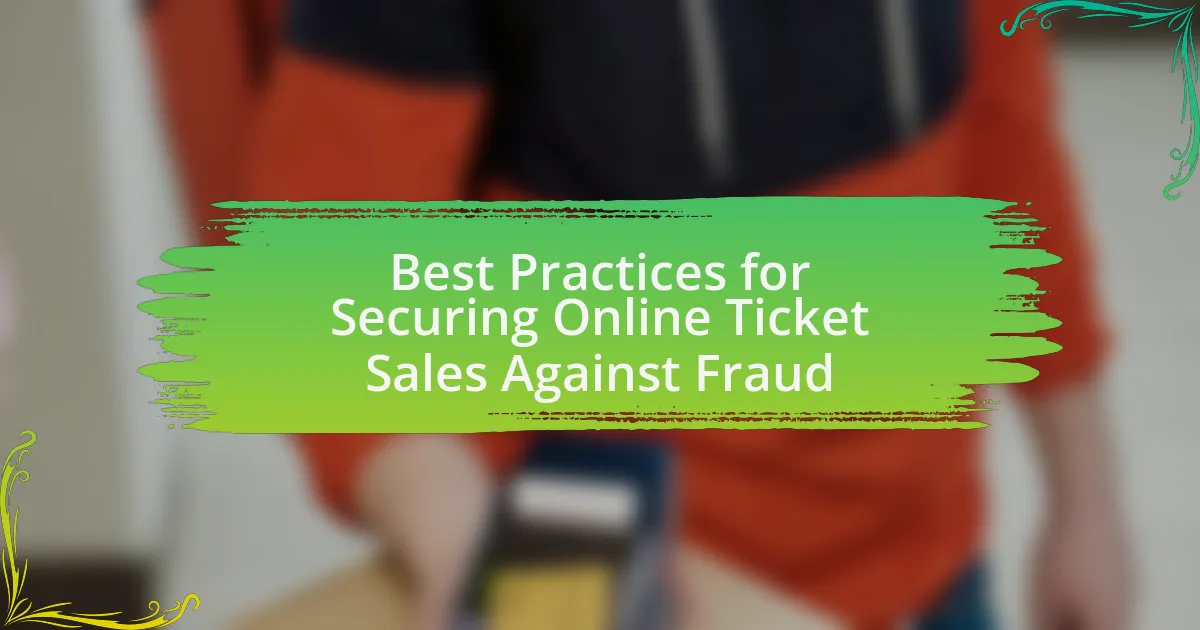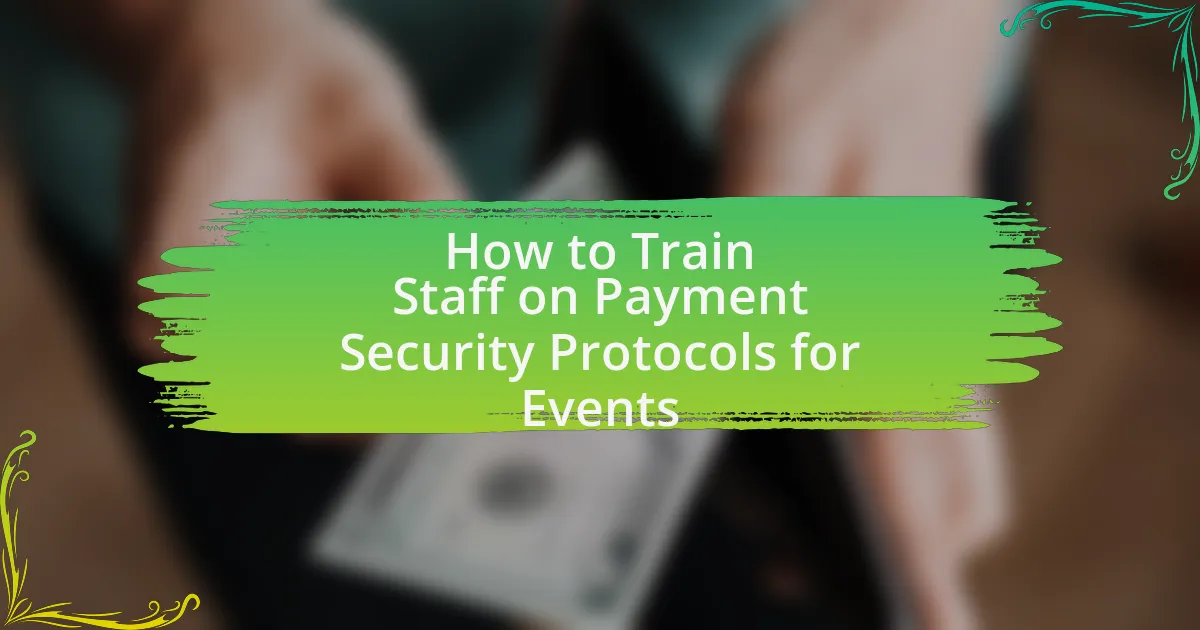Mobile payment security is essential for protecting attendees at live events, where high transaction volumes make financial systems vulnerable to fraud and cyberattacks. This article outlines the critical components of mobile payment security, including encryption, tokenization, and secure authentication methods, which work together to safeguard sensitive financial information. It also addresses the risks attendees face without proper security measures, such as financial fraud and identity theft, and highlights the potential consequences for event organizers in the event of a security breach. Furthermore, the article discusses common threats to mobile payment security, best practices for enhancing security, and the importance of educating staff and attendees on recognizing and mitigating risks.
What is Mobile Payment Security in the Context of Live Events?
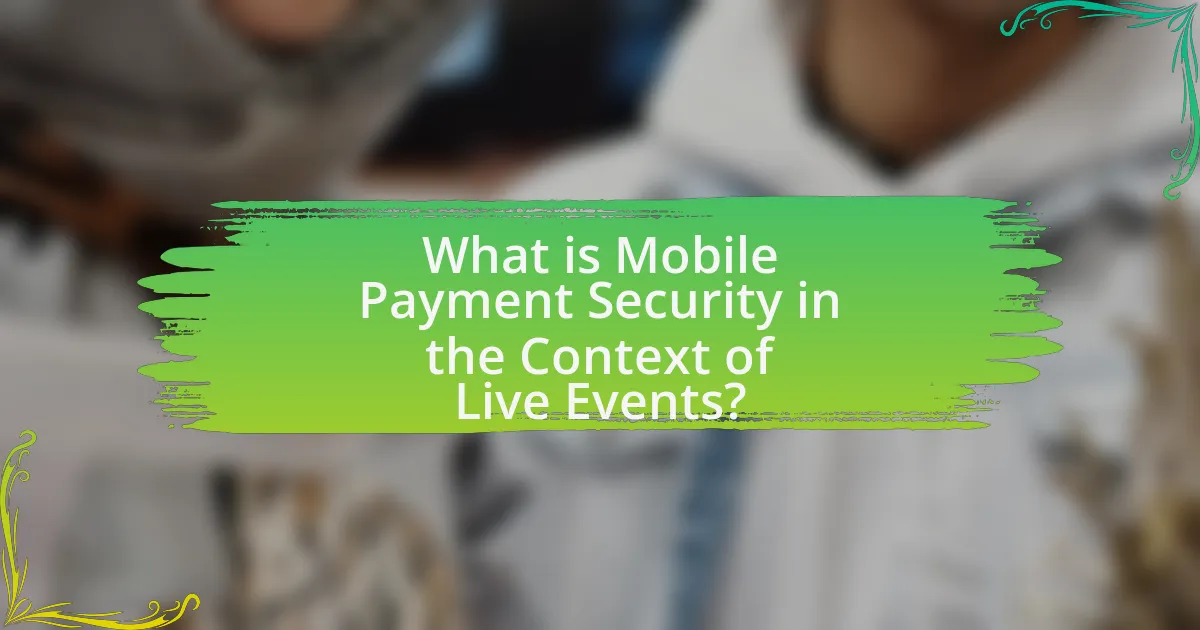
Mobile payment security in the context of live events refers to the measures and protocols implemented to protect financial transactions made via mobile devices during such events. This security is crucial as live events often involve high volumes of transactions, making them attractive targets for fraud and cyberattacks. Effective mobile payment security includes encryption of payment data, secure payment gateways, and compliance with standards such as the Payment Card Industry Data Security Standard (PCI DSS), which mandates strict security measures for handling card information. These protocols help ensure that attendees’ financial information remains confidential and secure, thereby fostering trust and encouraging the use of mobile payments at live events.
How does Mobile Payment Security protect attendees at live events?
Mobile payment security protects attendees at live events by employing encryption, tokenization, and secure authentication methods. These technologies ensure that sensitive financial information is not transmitted in plain text, reducing the risk of data breaches. For instance, encryption scrambles data during transmission, making it unreadable to unauthorized parties. Tokenization replaces sensitive data with unique identifiers, further safeguarding personal information. Additionally, secure authentication methods, such as biometric verification or two-factor authentication, ensure that only authorized users can access payment systems. According to a report by the Federal Trade Commission, implementing these security measures can significantly decrease the likelihood of fraud, thereby enhancing the overall safety of mobile transactions at events.
What are the key components of Mobile Payment Security systems?
The key components of Mobile Payment Security systems include encryption, tokenization, secure authentication, and compliance with security standards. Encryption protects sensitive data by converting it into a secure format that can only be read by authorized parties, ensuring that transaction details remain confidential. Tokenization replaces sensitive information with unique identifiers or tokens, minimizing the risk of data breaches during transactions. Secure authentication methods, such as biometrics or two-factor authentication, verify the identity of users, preventing unauthorized access to payment systems. Compliance with security standards, such as PCI DSS (Payment Card Industry Data Security Standard), ensures that mobile payment systems adhere to established security protocols, further safeguarding user data and transactions.
How do these components work together to ensure safety?
Mobile payment security components work together to ensure safety by implementing encryption, authentication, and tokenization. Encryption protects sensitive data during transmission, making it unreadable to unauthorized parties. Authentication verifies the identity of users and devices, ensuring that only legitimate transactions occur. Tokenization replaces sensitive information with unique identifiers, reducing the risk of data breaches. Together, these measures create a multi-layered security framework that significantly mitigates the risk of fraud and unauthorized access, thereby enhancing the overall safety of mobile payments at live events.
Why is Mobile Payment Security crucial for live events?
Mobile Payment Security is crucial for live events because it protects sensitive financial information from theft and fraud. With the increasing use of mobile payments at events, the risk of cyberattacks and data breaches rises significantly. According to a report by the Identity Theft Resource Center, data breaches in 2020 affected over 37 million individuals, highlighting the vulnerability of personal information. Ensuring robust mobile payment security measures, such as encryption and tokenization, helps safeguard attendees’ data, fosters trust, and enhances the overall event experience.
What risks do attendees face without proper Mobile Payment Security?
Attendees face significant risks without proper mobile payment security, including financial fraud, data breaches, and identity theft. Financial fraud can occur when attackers intercept payment information, leading to unauthorized transactions. Data breaches expose sensitive personal and financial information, which can be exploited for malicious purposes. Identity theft can result from compromised data, allowing criminals to impersonate individuals for financial gain. According to a report by Javelin Strategy & Research, in 2020, 49 million Americans were victims of identity theft, highlighting the critical need for robust mobile payment security measures to protect attendees at live events.
How can breaches in Mobile Payment Security impact event organizers?
Breaches in mobile payment security can significantly impact event organizers by leading to financial losses, reputational damage, and legal liabilities. When mobile payment systems are compromised, event organizers may face direct financial repercussions due to fraudulent transactions, which can result in lost revenue and increased costs for remediation. Additionally, a security breach can erode trust among attendees, leading to decreased ticket sales and negative publicity. According to a 2021 report by IBM, the average cost of a data breach is approximately $4.24 million, highlighting the financial stakes involved. Furthermore, event organizers may also encounter legal challenges, as they could be held accountable for failing to protect customer data, potentially resulting in fines and lawsuits.
What are the Common Threats to Mobile Payment Security at Live Events?
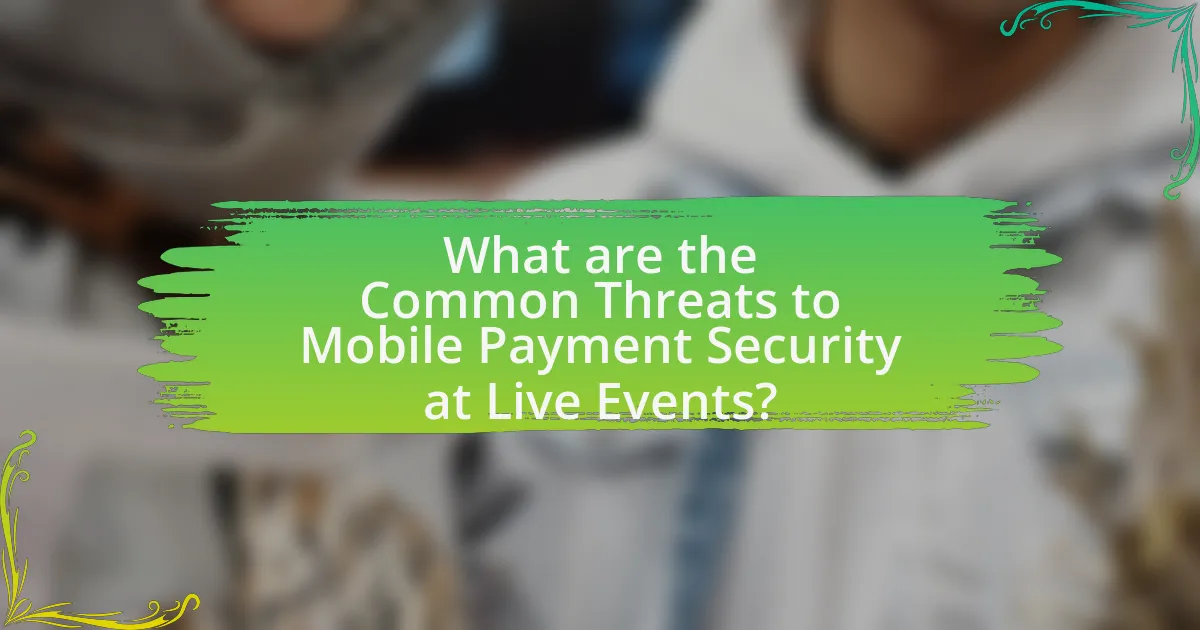
Common threats to mobile payment security at live events include data interception, phishing attacks, and insecure Wi-Fi networks. Data interception occurs when attackers capture sensitive information transmitted during mobile transactions, often through man-in-the-middle attacks. Phishing attacks target users through deceptive messages or websites, tricking them into revealing personal information or login credentials. Insecure Wi-Fi networks, frequently set up at live events, expose users to risks as attackers can easily access unencrypted data being transmitted over these networks. According to a report by the Federal Trade Commission, over 30% of mobile payment users have experienced security issues, highlighting the prevalence of these threats.
What types of cyber threats are prevalent at live events?
Cyber threats prevalent at live events include Wi-Fi eavesdropping, payment card skimming, and phishing attacks. Wi-Fi eavesdropping occurs when attackers intercept data transmitted over unsecured networks, which are often set up at events for attendee convenience. Payment card skimming involves the use of malicious devices to capture card information during transactions, posing a significant risk as mobile payments become more common. Phishing attacks target attendees through deceptive emails or messages, aiming to steal personal information or login credentials. According to a report by the Cybersecurity and Infrastructure Security Agency, these threats have increased in frequency as more events adopt digital payment systems, highlighting the need for robust security measures.
How do phishing attacks target mobile payment users?
Phishing attacks target mobile payment users primarily through deceptive messages and fraudulent websites designed to steal sensitive information. Attackers often send SMS or email messages that appear to be from legitimate payment services, prompting users to click on links that lead to counterfeit websites resembling the official ones. According to a report by the Anti-Phishing Working Group, there was a 22% increase in phishing attacks targeting mobile users in 2021, highlighting the growing threat. These attacks exploit the convenience of mobile payments, as users may be less cautious when accessing links on their devices, leading to compromised accounts and financial loss.
What role do malware and hacking play in compromising security?
Malware and hacking significantly compromise security by exploiting vulnerabilities in systems to gain unauthorized access to sensitive information. Malware, such as keyloggers and ransomware, can infiltrate devices used for mobile payments, capturing personal data and financial information. Hacking techniques, including phishing and man-in-the-middle attacks, can intercept transactions and manipulate data during live events, leading to financial loss and identity theft. According to a report by Cybersecurity Ventures, cybercrime is projected to cost the world $10.5 trillion annually by 2025, highlighting the severe impact of these threats on security.
How can event organizers identify potential security vulnerabilities?
Event organizers can identify potential security vulnerabilities by conducting thorough risk assessments and utilizing security audits. Risk assessments involve evaluating the event’s specific environment, including entry points, crowd management, and technology used, to pinpoint areas that may be susceptible to threats. Security audits, which can include penetration testing and vulnerability scanning, help in identifying weaknesses in the systems and processes that handle mobile payments. For instance, a study by the National Institute of Standards and Technology emphasizes the importance of regular security assessments to mitigate risks associated with mobile payment systems.
What tools and techniques are available for vulnerability assessment?
Tools and techniques available for vulnerability assessment include automated scanning tools, manual testing methods, and threat modeling frameworks. Automated scanning tools, such as Nessus and Qualys, systematically identify vulnerabilities in systems by scanning for known issues and misconfigurations. Manual testing methods, including penetration testing, involve security professionals simulating attacks to discover vulnerabilities that automated tools may miss. Threat modeling frameworks, like STRIDE and DREAD, help organizations identify potential threats and assess their impact, guiding the prioritization of vulnerabilities. These methods collectively enhance the security posture of mobile payment systems at live events by identifying and mitigating risks effectively.
How can attendee behavior indicate security risks?
Attendee behavior can indicate security risks through patterns such as unusual crowd movement, excessive loitering, or individuals displaying signs of distress. For instance, if attendees are frequently checking their surroundings or moving away from designated areas, it may suggest a heightened sense of threat or discomfort. Additionally, behaviors like attempting to access restricted areas or engaging in suspicious interactions with others can signal potential security breaches. These behaviors are critical for security personnel to monitor, as they can lead to proactive measures that mitigate risks, ensuring the safety of all participants at live events.
What Best Practices Can Enhance Mobile Payment Security at Live Events?
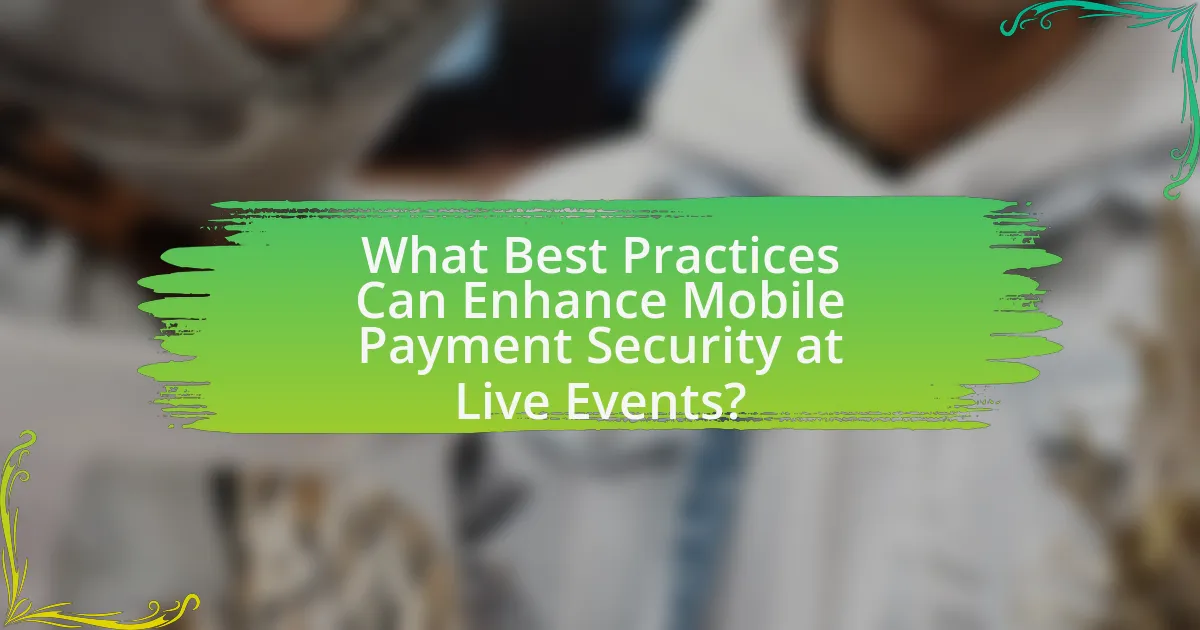
Implementing strong encryption protocols is a best practice that can significantly enhance mobile payment security at live events. Encryption protects sensitive data during transmission, making it difficult for unauthorized parties to intercept and misuse information. According to the Payment Card Industry Data Security Standard (PCI DSS), organizations must encrypt cardholder data that is transmitted over open and public networks, which is particularly relevant in crowded environments like live events where security risks are heightened. Additionally, utilizing tokenization can further safeguard payment information by replacing sensitive data with unique identifiers, reducing the risk of data breaches. Regular security audits and employee training on recognizing phishing attempts and other cyber threats also contribute to a more secure mobile payment environment at events.
How can event organizers implement effective security measures?
Event organizers can implement effective security measures by conducting thorough risk assessments and employing a multi-layered security approach. This includes utilizing trained security personnel, deploying surveillance systems, and implementing access control measures to monitor and manage attendee flow. According to the International Association of Venue Managers, events with comprehensive security plans reduce incidents by up to 30%. Additionally, integrating technology such as mobile payment systems with encryption and tokenization enhances transaction security, protecting attendees’ financial information.
What role does encryption play in securing mobile payments?
Encryption plays a critical role in securing mobile payments by protecting sensitive financial information during transmission. It ensures that data such as credit card numbers and personal identification details are converted into a coded format, making it unreadable to unauthorized parties. For instance, the use of Advanced Encryption Standard (AES) is common in mobile payment systems, which provides a high level of security by encrypting data with a key size of 128, 192, or 256 bits. This encryption process not only safeguards user data from interception but also helps in maintaining compliance with regulations such as the Payment Card Industry Data Security Standard (PCI DSS), which mandates encryption as a key security measure.
How can multi-factor authentication improve security for attendees?
Multi-factor authentication enhances security for attendees by requiring multiple forms of verification before granting access to sensitive information or services. This method significantly reduces the risk of unauthorized access, as it combines something the user knows (like a password) with something the user has (such as a mobile device for a one-time code). According to a study by the Cybersecurity & Infrastructure Security Agency, implementing multi-factor authentication can block up to 99.9% of automated cyber attacks, thereby protecting attendees’ personal and financial data during mobile payments at live events.
What training and resources are available for staff and attendees?
Training and resources available for staff and attendees include workshops on mobile payment security, online courses, and informational materials that cover best practices for secure transactions. These resources are designed to educate staff on identifying potential security threats and implementing protective measures, while attendees receive guidance on safely using mobile payment options at events. For instance, organizations often provide access to training modules that detail the latest security protocols and technologies, ensuring that both staff and attendees are well-informed about safeguarding their financial information during live events.
How can staff be educated on recognizing security threats?
Staff can be educated on recognizing security threats through comprehensive training programs that include workshops, simulations, and regular updates on emerging threats. These programs should cover specific scenarios related to mobile payment security, such as identifying phishing attempts, understanding social engineering tactics, and recognizing suspicious behavior at live events. Research indicates that organizations that implement ongoing security awareness training see a 70% reduction in security incidents, highlighting the effectiveness of such educational initiatives.
What resources can attendees access to protect their mobile payments?
Attendees can access various resources to protect their mobile payments, including mobile payment security apps, secure payment platforms, and educational materials on safe payment practices. Mobile payment security apps, such as antivirus software and VPN services, help safeguard personal information during transactions. Secure payment platforms, like PayPal and Apple Pay, offer encryption and fraud protection features. Additionally, educational materials provided by event organizers can inform attendees about recognizing phishing attempts and using two-factor authentication, enhancing their overall security awareness.
What are the key takeaways for ensuring Mobile Payment Security at live events?
To ensure mobile payment security at live events, implement strong encryption protocols and secure payment gateways. Utilizing end-to-end encryption protects sensitive data during transactions, while secure payment gateways minimize the risk of fraud. Additionally, regularly updating software and applications helps to patch vulnerabilities that could be exploited by cybercriminals. Educating staff and attendees about recognizing phishing attempts and using secure networks further enhances security. According to a report by the Federal Trade Commission, 43% of data breaches involve small businesses, highlighting the importance of robust security measures at events.
